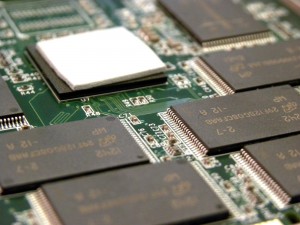Data recovery laboratories can restore data from fire-damaged hard drives, flooded servers, and ransomware-infected RAID arrays — but if you break a memory card in half, many professional providers will refuse to take the case.
Unfortunately, breaking a NAND memory chip in half will effectively cause permanent data loss. Below, we’ll explain why.
If you can’t access data on a flash drive, solid-state drive (SSD), hard drive, or any other device, we’re here to help. Set up a free evaluation online or call 1-800-237-4200 to speak with a member of our team.
Why does cracking a NAND flash drive make data recovery impossible?

An SSD’s internal NAND chips and controller.
The short answer: The technology to repair a NAND flash chip does not exist, and will not exist for the foreseeable future.
The long answer: NAND flash memory chips are constructed from dies, which contain one or more plane, which is further divided into blocks and pages. Pages consist of an array of transistors, which store electrical charges to indicate the presence of data. The standard manufacturing process for NAND is to create dies, then discard any dies that are defective.
This is an intentional oversimplification, but it’s accurate enough to get the point across: Manufacturing and repair are different processes. The manufacturing process is not especially precise, and the technology to repair damaged dies is not currently available.
Developing that repair technology would likely be as expensive as developing the technology to manufacture NAND at scale — that would be an investment of a billion dollars or more. There simply isn’t enough demand for NAND flash repair to justify that level of investment.
And that’s assuming that NAND repair is physically possible. The transistors on NAND memory chips are incredibly small, and breaking a die apart could cause irreparable damage. Even if the data still existed on the chip after the failure, attempting to power up the damaged NAND device would send electricity across damaged transistors, which would almost certainly cause permanent data loss.
Related: What Is Chip-Off Data Recovery for Flash Media?
Is there any hope for data recovery from damaged flash memory chips, if technology improves in the future?
Theoretically, yes. If the stored charge of the gate oxide layer of the chips could be probed without harming the integrity of the data, the method would be viable.
The most promising technology is Scanning Kelvin Probe Microscopy (SKPM), which could enable engineers to examine the charges on individual transistors and reconstruct those into usable data, without running a charge through the damaged chips. SKPM is expensive and time consuming, and it’s most appropriate for computer forensics cases (when collecting evidence relative to the source of the damage may be more valuable than restoring the data to a usable state).
SKPM is currently too limited to be utilized for NAND flash media data recovery — or for most forensics cases, for that matter — but it’s an ongoing area of research for professional data recovery laboratories.
My flash card or USB drive isn’t readable. Is data recovery possible?
While physical media damage isn’t ideal, it doesn’t always mean that your data is gone forever. For example, if the USB port on your flash drive is broken, the chips are probably intact. The data should be fully recoverable, provided that your data recovery provider has experience with this type of case.
Datarecovery.com provides evaluations for all NAND flash devices. Our engineers can determine whether data is recoverable, and our no data, no charge guarantee ensures that you don’t pay for failed attempts.
To learn more, set up a case online or call 1-800-237-4200 to speak with an expert.




